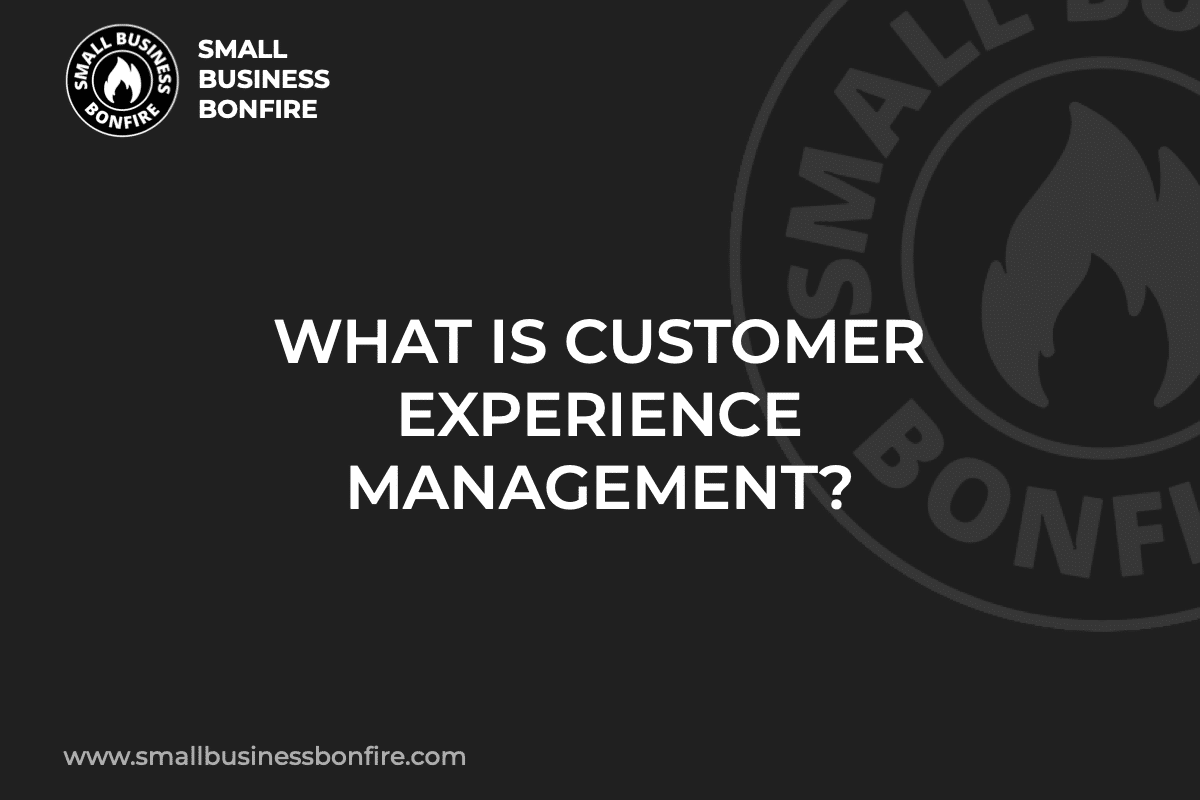Are you struggling to create personal, unforgettable experiences with your customer base?
Don’t worry if this sounds like you! Plenty of small business owners have difficulty creating meaningful customer relationships.
Hi, my name is AJ! After selling my business for multiple seven figures, I made it my mission to help other entrepreneurs find success with their companies!
Building a business taught me a lot. One lesson I’ll always remember is why small businesses must collect and utilize customer data to generate excellent experiences.
So, if you’re ready to take your customer interactions to the next level, it’s time to learn about customer experience management (CXM)!
Key Takeaways
- CXM is a customer-centric approach to business processes.
- CXM tools help companies increase customer retention rates and satisfaction levels.
- Delivering personalized experiences increases the likelihood of customers shopping with your brand repeatedly.
- One effective CXM strategy is to segment customers with similar interests or preferences.
Related Reading: Best CRM for Small Businesses
SBB Featured Partners
What is Customer Experience Management (CXM)?
Customer experience management aims to create the best and most personalized customer interactions.
As businesses collect customer data and work toward meaningful engagements, things like customer satisfaction, loyalty, and word-of-mouth marketing start to increase.
With customer experience management, companies focus on personalization at all customer touchpoints.
Lastly, this approach builds customer relationships further than basic marketing and sales pitches offer.
Customer Experience Management Benefits
If you’ve never heard of customer experience management until today, you’re probably curious about why you should focus on it.
The truth is that CXM systems and strategies are highly beneficial for any business.
Let’s look at five advantages you can enjoy with a CXM strategy!
Better Understanding of Customer Base
With CMX, you and your team can better understand customer preferences and behaviors!
Why is this helpful?
Well, when you understand what keeps your customer base happy, your marketing team can deliver incredibly personalized ads and experiences.
As a result of each excellent customer engagement, you’ll notice an increase in sales conversions!
Further, customers prefer shopping with brands that make them feel as unique as they are!
Most consumers will continue shopping with a brand that offers an excellent shopping experience even if the prices are higher than competitors: that’s how understanding your customers can impact your business!
Increased Customer Loyalty
When you focus on providing personalized experiences, customers tend to become loyal to your brand!
Why?
Because customers appreciate the feeling of being valued by the company they purchase products from.
Now, that’s a win-win situation for both you and your customer base!
Consumer loyalty also increases the chances of word-of-mouth marketing.
When people love a company’s products or services, they want to tell everyone about it!
Word-of-mouth marketing is especially important because of social media.
Who knows, one of your customers might have a massive Instagram following and want to brag about your products: that’s free advertising to thousands of people!
Increased Customer Retention
This advantage relates closely to increasing brand loyalty.
An excellent customer experience makes it likelier for your target audience to continue shopping with your brand the next time they need your products or services.
Retaining customers should be your team’s primary focus because selling to repeat customers is MUCH less expensive than finding new customers!
Maintain a Competitive Advantage
Do you know what sets your company apart from its competitors?
If customers can’t answer that question, they’ll be more likely to shop with your competition.
With customer experience management strategies, you can provide unique services and products no one else offers!
Separating your brand from others like yours is critical because consumers have several choices for purchasing products and services.
Better Customer Analytics
Lastly, CXM techniques allow your company to gather in-depth customer data to help drive marketing and sales campaigns.
CXM systems are quite advanced, ensuring your company collects and organizes every little piece of the customer experience to use in the future.
Better, more in-depth data allows your company to increase customer satisfaction and sales!
CRM Vs. CXM: What's the Difference?
Customer relationship management (CRM) software is similar to CXM technology in some respects.
Still, there are a handful of distinctions to be aware of, ensuring your company invests in the correct technology!
Customer Relationship Management (CRM)
What is CRM? The primary focus of customer relationship management technology is to nurture long-term relationships.
Further, CRM systems find, collect, and organize customer data, allowing your sales and marketing teams to deliver ads and messages that resonate with them.
Another detail CRM tools help with is streamlining and organizing business processes.
For instance, CRM systems include sales and marketing automation software, allowing your employees to work on vital tasks while the software handles the mundane, repetitive tasks.
CXM
A customer experience tool focuses on after-sales processes.
Therefore, CXM completes tasks like:
- Collecting customer feedback after a sale
- Delivering messages and interactions that maintain a healthy relationship
- Track each customer’s view of your brand
- Collect and organize qualitative data about potential and current customers to develop a deeper understanding of their needs
CXM aims to understand customer sentiment!
A similarity CXM approaches share with CRM systems is that they focus on driving profitability by emphasizing customer interactions.
Customer Experience Management Strategies
How can your company use customer experience management to your benefit?
Here are four proven strategies to help take each customer journey a step above your competition’s!
Segmenting Customers
Creating a top-notch customer experience starts with creating customer segments.
Segmentations allow you to gain a deeper understanding of the needs and wants of your target audience.
Some examples of customer segmentation include the following:
- Age
- Spending habits
- Pain points
- Previous purchases
- Preferred social media platform
- Physical location
Also, with successful customer segmentation, you can pinpoint problems and shared pains, allowing you to create and implement strategies that prevent churn.
Personalized Messaging
Once your team has created customer segments, you can start crafting messages that deliver personalized experiences.
For instance, personalizing emails allows your company to focus on customer needs and preferences directly.
Another form of personalized messaging is targeting ads that fit each customer segment’s desires.
In today’s world, part of customer expectations includes some form of personalization!
Omnichannel Communication
Are you familiar with the term omnichannel?
An omnichannel approach ensures business customers receive consistent service across all communication channels (social media, mobile apps, email, etc.).
Centralizing customer data in a customer experience management platform ensures customer experiences are easily accessible to ALL team members.
As a result, your business delivers a consistent brand experience.
Improved Customer Feedback
The customer journey doesn’t end after a purchase.
After each transaction, your company should request customer feedback to measure the overall experience.
Customer feedback is constructive for understanding your target audience more deeply and helps you stay ahead of the competition by improving your customer experience management strategy!
Customer Experience Management Examples
Below, I’ve listed two examples to help you better understand how beneficial the customer experience management mindset can be for your company!
Let’s see how Amazon and Apple excel in managing customer experience.
Amazon’s Personalized Shopping Experience
Amazon is a prime example (pun intended) of effective customer experience management.
The company’s platform aims to personalize the shopping experience for each user, providing product recommendations based on browsing history and past purchases.
This strategy creates a positive customer experience, makes shopping more convenient for Amazon customers, and increases the likelihood of additional purchases, thereby driving revenue growth.
Apple’s Exceptional Customer Support
Apple is renowned for its customer support, part of its broader customer experience management strategy.
Whether in-store at the Genius Bar or online support, Apple ensures that every touch point focuses on resolving customer issues efficiently.
By prioritizing customer support, Apple enhances customer satisfaction and collects more loyal customers, distinguishing itself from other tech companies.
Customer Journey and Customer Experience Management
The customer journey and experience management are two sides of the same coin, each playing a vital role in shaping how a customer perceives your brand.
For example, the customer journey is the path a customer takes from first interaction to final purchase or engagement, encompassing all customer touchpoints along the way.
On the other hand, CXM is when companies design and react to these customer interactions to meet or exceed customer expectations, fostering customer loyalty and satisfaction.
Put simply, the customer journey is the roadmap, while CXM is the vehicle driving that entire journey, ensuring a satisfying and seamless customer experience at every turn!
How to Build a Good Customer Experience Management Strategy
You’re ready to create a CXM plan for your company by now!
But where should you start?
Follow my six-step plan for a successful customer experience management platform!
Step 1: Understand Your Customers
The first step is gathering quantitative and qualitative data about your existing customers.
In-depth market research and strategies like Customer Choice Analysis help your team segment your customers and better understand who they are as consumers.
These actionable insights also allow you to track everyday experiences in customer journey maps.
Step 2: Define Relevant Goals
After understanding customers, you’ll need to define the goals and metrics of your CXM strategy.
Some examples of relevant customer-centric goals include:
- Increase customer loyalty
- Enhance customer satisfaction
- Reduce churn rate
You can also create economic goals and key performance indicators (KPIs) for employees.
Some examples of economic goals include the following:
- Increase sales by 10%
- Increase conversion rates
- Increase employee productivity by 15%
The corresponding metrics for these goals should be measurable and time-bound.
Goals benefit your company by giving every team member objectives to focus on and strive toward!
Step 3: Design Your Customer Experiences
The third step in creating an exceptional CXM strategy is designing custom experiences for every segment.
When designing customer experiences, ensure you rely on the feedback and suggestions of EVERY department, not just your sales or marketing team.
Gathering recommendations from various sources ensures the experiences are tailored to each customer segment.
Step 4: Build Internal Capabilities
Next is building internal capabilities.
That said, you must create a customer journey map that includes the following aspects:
- Processes
- Structures
- Personnel
- Knowledge
- Skills Technology
- Tools
- Information
- Culture
Creating this roadmap ensures your company has the resources and know-how to deliver the ideal customer experience.
If you don’t have every single internal capability to offer your targeted customer experience, create plans and techniques to get you there!
Remember, creating a personalized, exceptional customer journey is worth investing some time and money into.
Step 5: Customer Relationship Structures
The fifth step is creating an organization-wide customer relationship structure.
Structuring consumer relationships ensures your team is prepared to handle things as customers change.
Some details to consider when structuring relationships include the following:
- What customer-centric processes will your team need to adapt?
- What customer information can you use as consumers change?
- What sales channels will be effective as customers change?
Having this “customer playbook” on hand as aspects change and customers make their way through the sales funnel is essential because customer journeys change.
Step 6: Customer Data Measurement and Analytics
The final step is crucial: you must measure and analyze customer data!
Monitor how successful your CXM strategies are by measuring things like:
- Customer lifecycle length
- Customer churn rate
- Customer behavior throughout the sales process
- How customers interact with communication channels
- Customer engagement levels
- Brand loyalty
I’ve seen numerous small businesses fail to analyze and monitor their CXM strategies, leading to fewer sales and missed opportunities to get a leg up on the competition!
It’s best to analyze customer data weekly or bi-weekly. That way, you stay on top of trends and strategies that need improvements or alterations.
Customer Experience Management Software
Managing customer experience is a million times easier with software to help track and organize the entire customer journey!
With so many software providers in the industry, it’s challenging to know what to look for, how to choose, and what a reasonable price is.
Don’t worry; I’ve got you covered! Below is everything you need to know about CXM systems!
What is Customer Experience Management Software?
Customer experience management (CXM) software is a digital tool designed to help businesses manage and improve the overall customer experience.
A CXM system tracks, organizes, and analyzes customer interactions across multiple touchpoints.
As a result, businesses create a cohesive, integrated view of customer journeys.
Additionally, CXM technology can do the following things:
- Capture customer feedback in real-time
- Analyze data to provide insightful customer behavior patterns
- Automate personalized communications via email or social media
- Find ways to optimize customer relationships at various touchpoints
In essence, CXM software enables businesses to understand their customers better, anticipate their needs, and deliver a superior, personalized customer experience that drives loyalty and growth.
How to Choose a Customer Experience Management Software
When looking for customer experience technologies, there are several factors to consider.
Most importantly, you and your team must discuss how you want to use the software.
Or what your team’s goals are when implementing CXM technology.
For example, will your company use CXM software to build customer loyalty programs or to track areas of improvement in the customer life cycle?
Understanding why your business needs CXM software will help you search for the right features.
Other necessary things to consider when searching for a CXM solution include the following:
- Price
- Payment plans (will you pay per user or data you use?)
- Features (marketing automation, inbox management, scheduling, etc.)
- CRM integration
- Third-party app integrations
- Detailed reports and data
- AI capabilities (natural language processing, digital transformation, automation, etc.)
Lastly, you must not rush the selection process when searching for a CXM tool.
If you wind up choosing technology that can’t fit your business’s demands, it can cost a lot of time and money!
Customer Experience Management Software Examples
Here are two CXM software providers to consider as you search for the best platform for your business.
Adobe Experience Manager (AEM)
Adobe is well-known for its high-tech products that people of all experience levels can use.
The AEM software is excellent for understanding and managing the entire customer journey.
AEM provides features and tools like:
- Data on how customers use your website
- Data on how customers use your app
- Digital asset management
- Content distribution across multiple channels
Customers constantly rave about how easy AEM is to use.
AEM is the customer engagement tool to use if you want valuable insights and a personalized software interface.
Zendesk
Another popular CXM provider is Zendesk!
Zendesk attracts so many users because of the top-notch features it offers.
For instance, some of the features Zendesk offers include the following:
- Live chat software
- Tracking and reporting
- Automation
- Ticketing routing
- Self-service portal
- Knowledge base
Also, Zendesk allows users to customize various aspects, like workflows and customer support solutions.
Zendesk has all the right tools to help your business retain customers while understanding their needs better!
Customer Experience Management Final Thoughts
A customer experience strategy can take your business to the next level, helping you boost sales and drive brand loyalty.
A customer experience platform collects and organizes customer data, allowing teams to understand their target audience better.
As a result, each customer interaction is tailored to an individual’s needs and preferences (which customers love!).
How will your team boost customer interactions? Let us know in the comments section below!
And good luck finding the right CXM platform for your business needs!
Newsletter Signup
Join The Leads Field Guide Newsletter for tips, strategies and (free) resources for growing your leads, and closing more deals.




